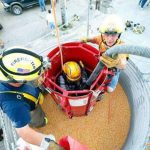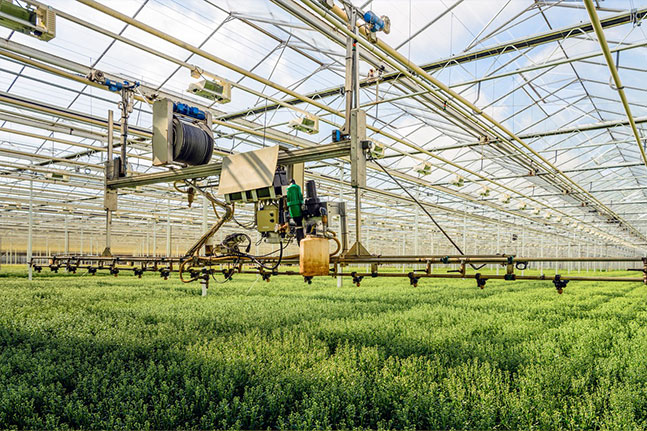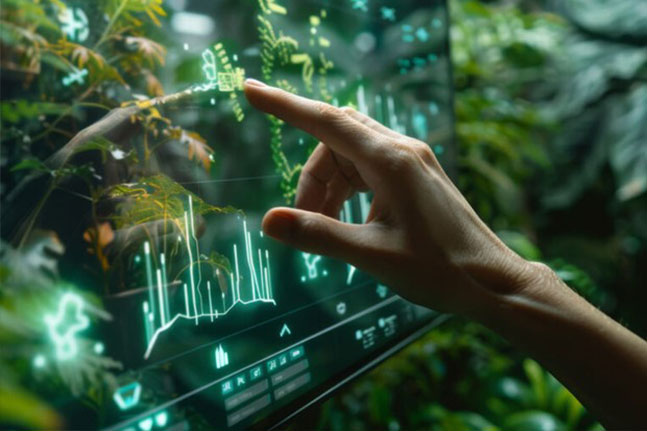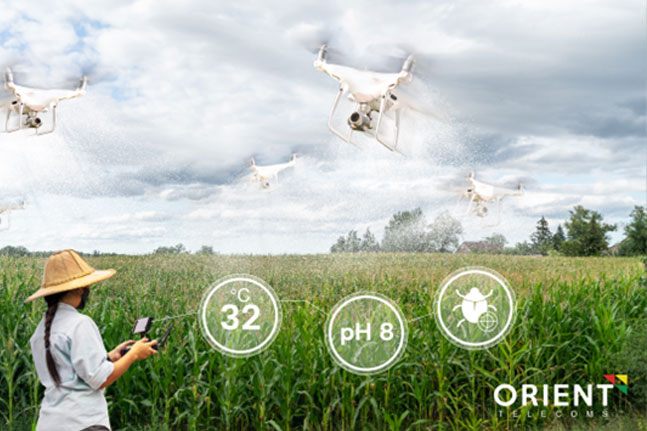
8 TIPS FOR LONG-TERM GRAIN STORAGE
May 28, 2024
HOW TO KEEP AGRICULTURAL WORKERS SAFE FROM COMMON GRAIN BIN HAZARDS
August 20, 2024Innovation is more important in modern agriculture than ever before. The industry as a whole is facing huge challenges: from rising costs of supplies and labor shortages to changes in consumer preferences for transparency and sustainability. There is increasing recognition from agriculture corporations that immediate solutions are needed for these challenges. Thankfully agriculture technology, also known as agtech is here.
This new concept refers to the use of technology in farming and agricultural practices to increase efficiency, productivity, and sustainability in food production. It includes several different types of technologies, such as precision agriculture, smart irrigation, biotechnology, and automation. Additionally, there are significant technological advancements in areas like indoor vertical farming, livestock technology, modern greenhouse practices, artificial intelligence, and blockchain, which we will explore further in this article.
INDOOR VERTICAL FARMING
Indoor vertical farming can increase crop yields, overcome limited land area, and even reduce farming’s impact on the environment by cutting down the distance traveled in the supply chain. This new concept can be defined as the practice of growing produce stacked one above another in a closed and controlled environment. Its key attribute is that it can significantly reduce the amount of land space needed to grow plants compared to traditional farming methods.
Vertical agriculture has the added value that in some setups it doesn’t require soil for plants to grow. Most are either hydroponic -the plants grow in a nutrient-dense bowl of water, or aeroponic, where the plant roots are systematically sprayed with water and nutrients.
Vertical farms use up to 70% less water than traditional farms.
From sustainable urban growth to maximizing crop yield with reduced labor costs, the advantages of indoor vertical farming are apparent. This new agriculture technology can control variables such as light, humidity, and water to precisely measure year-round, increasing food production with reliable harvests.
Labor is also greatly reduced by using robots to handle harvesting, planting, and logistics, solving the challenge farms face from the current labor shortage in the agriculture industry.
THE BENEFITS OF FARM AUTOMATION
Farm automation, often associated with “smart farming”, is a technology that makes farms more efficient, as it automates the crop or livestock production cycle. An increasing number of AgTech companies are working on robotics innovation to develop drones, autonomous tractors, robotic harvesters, automatic watering, and seeding robots. Although these technologies are fairly new, the industry has seen an increasing number of traditional agriculture companies adopt farm automation into their processes, as its primary goal is to cover monotonous tasks.
LIVESTOCK FARMING TECHNOLOGY
The traditional livestock industry is a sector that is arguably the most important yet widely overlooked sector, as it provides much-needed renewable natural resources that we rely on every day.
Traditionally known as running the business of farms, cattle ranches, and other related agribusinesses, livestock management involves maintaining accurate financial records, supervising workers, and ensuring the proper care and feeding of animals. However, technological advancements in agriculture are revolutionizing the world of animal husbandry. These developments have greatly improved the industry, making the tracking and managing of livestock much easier and faster.
Livestock technology can enhance the productivity, welfare, and management of animals and livestock.
The “connected cow” concept is the result of equipping herds with sensors to monitor their health and increase productivity. By attaching individual wearable sensors to cows, producers can keep track of daily activity and health-related issues and make operational decisions quickly and easily.
Animal genomics is a new type of agriculture technology that can be defined as the study of the entire gene landscape of a living animal and how its interaction with others can influence the animal’s growth and development. Genomics helps livestock producers understand the genetic risk of their herds and determine the future profitability of their livestock. So, by being strategic with animal selection and breeding decisions, producers can optimize the profitability and yields of livestock herds.
Agtech has huge benefits for the industry. Data-driven decision-making leads to better and more efficient decisions that will improve the productivity of livestock herds.
MODERN GREENHOUSES
In recent decades, the greenhouse industry has transformed from small facilities used primarily for research and aesthetic purposes (i.e., botanic gardens) to much larger facilities that compete directly with land-based conventional food production. Combined, the entire global greenhouse market currently produces about $350 billion worth of vegetables annually, of which U.S. production comprises less than 1%.
Today, in large part due to the tremendous recent improvements in growing technology, the industry is witnessing a blossoming like no time before. Greenhouses are increasingly emerging that are large-scale, capital-infused, and urban-centered.
The entire global greenhouse market currently produces nearly US $350 billion in vegetables annually.
As the market has grown dramatically, it has also experienced clear trends in recent years. Modern greenhouses are becoming increasingly tech-heavy, using LED lights and automated control systems to perfectly tailor the growing environment. Successful greenhouse companies are scaling significantly and locating their growing facilities near urban hubs to capitalize on the ever-increasing demand for local food.
To accomplish these feats, the greenhouse industry is becoming increasingly capital-infused, using venture funding and other sources to build out the infrastructure to compete in the current market.
PRECISION AGRICULTURE TECHNOLOGY
Agriculture is undergoing an evolution – technology is becoming an indispensable part of every commercial farm. New precision agriculture companies are developing technologies that allow farmers to maximize yields by controlling every variable of crop farming such as moisture levels, soil conditions, and microclimates. By providing more accurate techniques for planting and growing crops, precision agriculture enables farmers to increase efficiency and manage costs.
Precision agriculture companies have found a huge opportunity to grow. A recent report by Grand View Research, Inc. predicts the precision agriculture market to reach $43.4 billion by 2025. The emerging new generation of farmers is attracted to faster, more flexible startups that systematically maximize crop yields.
BLOCKCHAIN AND FOOD TRACEABILITY
Blockchain’s ability to track owner records and tamper with security can be used to solve pressing problems in the current food system such as food fraud, safety recalls, supply chain inefficiencies, and food traceability. Its unique decentralized structure ensures verified products and practices, creating a transparent marketplace.
Food traceability has been at the center of recent food safety discussions, particularly with new advancements in blockchain applications. Due to the nature of perishable food, the food industry is extremely vulnerable to making mistakes that would ultimately affect human lives.
Blockchain can be used to solve urgent issues such as food fraud, safety recalls, supply chain inefficiency, and food traceability in the current food system.
Traceability is essential for the food supply chain. The current communication framework within the food ecosystem makes traceability a time-consuming task, since some parties are still tracking information on paper. The blockchain structure ensures that data points can be generated and shared securely by all parties along the food value chain, an accountable and traceable system.
Vast data points with proprietary labels can be recorded immediately without modification. As a result, a record of food movement from farm to table can be monitored in real-time.
The use cases of blockchain in food go beyond ensuring food safety. It also adds value to the current market by establishing a ledger in the network and balancing market pricing. The traditional price mechanism for buying and selling relies on the judgments of the involved players, rather than the information provided by the entire value chain. Giving access to data would create a holistic picture of supply and demand, a marketplace with immense transparency.
AGRICULTURE AND ARTIFICIAL INTELLIGENCE
These can monitor plant health, soil conditions, temperature, humidity, and more. The idea is to give farmers a better understanding of what’s happening on the ground through advanced technology that can tell them more than the naked eye can see. And not only is it more accurate, it’s also faster.
With remote sensors, algorithms interpret field perimeters as statistical data that farmers can understand and use in their decision-making. Algorithms process data and adapt and learn based on the data received. The more inputs and statistics collected, the better the algorithm can predict different outcomes. The goal is to enable farmers to use this artificial intelligence to make better decisions in the field, thereby achieving their goals of better harvests.
https://www.plugandplaytechcenter.com/resources/new-agriculture-technology-modern-farming/





